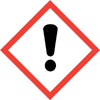24th March, 2021
How To Complete The COSHH Assessment Form
COSHH assessments are health and safety documents needed in nearly every type of business. Carrying out this assessment is a legal requirement, so you need to write it right. There are several steps to completing a COSHH assessment form. Follow these steps in order, as each stage leads to the next.

Carrying out a COSHH assessment is a legal requirement under the Control of Substances Hazardous to Health Regulations (COSHH Regulations). Most businesses use or create hazardous substances in one form or another. Dust from drilling, mixing paints, fumes from exhausts, fuel, chemicals, biological hazards - they all come under COSHH. Even using off the shelf cleaning solutions can trigger COSHH requirements.
To follow along with this guide, you can use the free blank COSHH assessment template or create your own.
There are several steps to completing a COSHH assessment form. You should follow these in order, as each stage leads to the next.
Identify Hazardous Substances
Your first step should be to identify hazardous substances used or produced within your business activities. These are the substances you need to control under the COSHH regulations. Identifying where you use or create hazardous substances highlights the tasks you should be assessing.
But how do you identify hazardous substances? Often substances are supplied to you, so an easy way to start is to look at the chemicals, liquids and solutions you buy. The COSHH regulations also apply to substances you create during your work, like dust, fumes and gases. And if you mix substances together, you need to assess the combined risk as part of your COSHH assessment. So also look at your processes. What materials do you alter? What mixtures do you create?
Here are some more details of the types of substances covered by COSHH and how to identify them.
Gather Information
Once you have identified the hazardous substance(s) you need to assess, you can gather safety information. If the product is purchased, you can ask for a copy of the safety data sheet. Usually, material safety data sheets (MSDS) get provided by your supplier. You can also often download them from the manufacturer's website. If you can't find a sheet for your substance, request a copy from your supplier.

The MSDS is a valuable source of health and safety information. The safety data sheet contains details of the known hazards and classifications of the material or substance and covers safe handling procedures, storage information, and advice. Much of this information can help in developing your COSHH assessment.
It shouldn't replace your COSHH assessment but instead, be used alongside it. The safety data sheet is generic advice for the substance. Your COSHH assessment will cover the specific risks your workers get exposed to in your particular use of the substance at work.
Header Section
Finally, you can start completing the COSHH assessment form. The first two steps (identifying hazardous substances and gathering information) might seem to make things take a little longer, but having this information to hand before you start your COSHH assessment will speed up the following stages.
So let's start by completing the header section. This section tells people which substance you are assessing and what you use it for (the activity or task). In the header section of the assessment, you should record the hazardous substance(s) used or produced, for example, cement. Also include what you use it for, e.g. mixing mortar, and the duration of use, for example, 1 hour per day.
Substance: Cement Date: 7th Jan 2019 Task: Mixing of mortar, concrete etc Duration: 2 hours Reference: COSHH001
Assess the Risk
In the next section, you should outline the risks people are exposed to when they use or come into contact with the substance. Don't forget to consider other people that might be at risk, not just those carrying out the task, for example, adjacent workers and the public. Your assessment needs to consider the risk to anyone that could come into contact with the substance.
If the substance has a classification symbol assigned to it, make sure you include that on your COSHH assessment. You can find this out from the packaging or on the safety data sheet. For example, if a substance is explosive or toxic, it will have a symbol. This visual information will help people using the substance quickly identify the risk.



Find out more about COSHH chemical hazard symbols and their meanings.
Think about the routes of exposure. A substance is harmful when it has contact with the body in some way. For example, a substance may be hazardous to the skin from touch. Another might be harmful to the respiratory system through inhalation. How could the substance harm someone? Once you know the routes of exposure, you can start to think about the controls needed. Control measures could include substitution, ventilation, extraction, and what PPE is required to protect users.
First Aid Measures
The purpose of your COSHH assessment is to prevent exposure. But things can sometimes go wrong, and you must also plan for emergencies. If harmful contact happens, quick action is vital, especially with high-hazard substances. People need to know what the correct first aid measures are, and these instructions should be in the COSHH assessment.
Consider the types of first aid needed if your control measures fail. For example, the action required for skin contact will be different from inhalation. The safety data sheet or industry guidance will outline recommended first aid advice. Consider if this applies to your activity and add the appropriate information to your assessment.
Remember to provide any first measures on-site. For example, if you instruct that " on contact with skin wash with soap, specialist hand cleaner and water ", you need to make sure that the soap, hand cleaner and water is available on site.
Injury Advice Skin For dry cement, remove and rinse abundantly with water.
For wet cement, wash skin with water. Remove contaminated clothing, footwear, watches, etc, and clean thoroughly before re-using them.
Seek medical treatment in all cases of irritation or burns.
Control Measures
Control measures are the steps you take to control the hazards presented by the substance. You could remove the risk by eliminating the substance, or reduce the risk by substituting it for a low hazard alternative. More often, your controls will be putting actions, procedures and safety equipment in place to protect users of the substance and others who may get exposed.
Find out more about the best control measures and the hierarchy of controls.
In the controls section, you should look at what you are doing already to protect your workforce. Then assess what extra control measures could improve safety. For example, when cutting paving slabs, you might already use water for dust suppression and dust masks to protect from the health risks of breathing in silica dust. You could also provide goggles to protect eyes and P3 respirators to give better respiratory protection.
Legally you must reduce the risks associated with exposure to the substance as low as is reasonably practicable (ALARP) to comply with the COSHH regulations. A combination of controls is often the best defence, don't only rely on PPE on its own.
Once you have completed your COSHH assessment, remember to monitor the process to check that your controls work. Review your assessment regularly. If you identify improvements, have an accident, or change the process, you should update your assessment. Decide on a suitable time frame to review the assessment. Depending on the risks involved, this may be annually or more often for high-risk substances.
Need help completing your COSHH assessments? Browse the library of pre-completed and ready to use COSHH assessment templates.
This article was written by Emma at HASpod. Emma has over 10 years experience in health and safety and BSc (Hons) Construction Management. She is NEBOSH qualified and Tech IOSH.
Need to know COSHH?
Take our COSHH awareness elearning course and get your certificate today.
COSHH CourseRecent posts like this...

What Is A COSHH Assessment?
The COSHH regulations require you to do a COSHH assessment when using or creating hazardous substances. Most businesses will need them. But what is a COSHH assessment, its purpose, and what does this document need to include?
Read Post
9 Ways To Comply With COSHH
The Control of Substances Hazardous to Health (COSHH) Regulations apply to every workplace. Here are nine ways you can comply with COSHH - including identifying hazardous substances, assessing the substances you use and produce in your workplace, controlling the risks, keeping records, and providing training.
Read Post
Where Does COSHH Apply?
COSHH is a law that requires employers to control substances that are hazardous to health. Most businesses use substances that are hazardous to health, from cleaning chemicals to creating gases, dust and vapours - so the COSHH regulations will apply to some aspects of most businesses.
Read Post